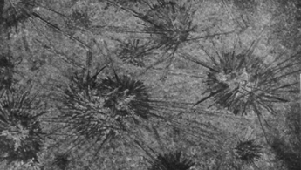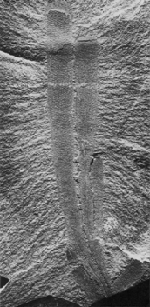Sponges
Choia ridleyi
 Choia, though rare, looked very much like a modern day
sea urchin. The needle-like spicules projecting from its body
were used to stabilize itself on the sea-floor. The colonial Choia fed by utilizing feeding cells to extract nutrients from the water.
Choia, though rare, looked very much like a modern day
sea urchin. The needle-like spicules projecting from its body
were used to stabilize itself on the sea-floor. The colonial Choia fed by utilizing feeding cells to extract nutrients from the water.
Vauxia gracilenta
 Vauxia, a branching sponge, was the most abundant species that Charles Walcott collected. Each branch was comprised of a network of strands. Vauxia also had a skeleton of spongin (flexible organic material) common to modern day sponges.
Much like Choia and other sponges, Vauxia fed by extracting nutrients from the water.
Vauxia, a branching sponge, was the most abundant species that Charles Walcott collected. Each branch was comprised of a network of strands. Vauxia also had a skeleton of spongin (flexible organic material) common to modern day sponges.
Much like Choia and other sponges, Vauxia fed by extracting nutrients from the water.
Return to the fossil menu
Table of contents